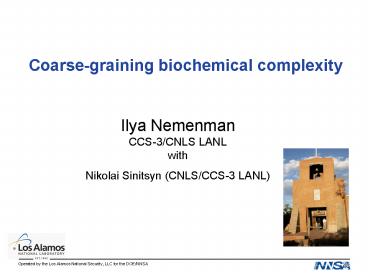Coarsegraining biochemical complexity PowerPoint PPT Presentation
1 / 19
Title: Coarsegraining biochemical complexity
1
Coarse-graining biochemical complexity
- Ilya Nemenman CCS-3/CNLS LANLwith
- Nikolai Sinitsyn (CNLS/CCS-3 LANL)
2
(No Transcript)
3
Topic
- Animal learning, multiscale or power-law memory
world is complex - Predictability, complexity, and learning. NeCo
2001 what is complexity (of a time series)? - Coarse graining biochemical networks how to deal
with complexity?
4
Biochemical complexityExample - IgE receptor
(From Faeder, Hlavacek, et al.)
354 species / 3680 reactions
5
Why such complexity?
6 free states
48 monomer states
g
2
300 dimer states
354 chemical species (2954 for trimers)
6
10 reactions/species(an example with a
relatively short RHS)
- XDOT(1) (1.0km1X(8)X(0)-2.0kp1X(7)X(1))/1.0
(1.0km1X(10)X(0)-2.0kp1X(9)X(1))/1.0 (
1.0km1X(28)X(0)-2.0kp1X(33)X(1))/1.0 (1.0
km1X(35)X(0)-2.0kp1X(17)X(1))/1.0 (1.0km1
X(40)X(0)-2.0kp1X(36)X(1))/1.0 (1.0km1X(43
)X(0)-2.0kp1X(37)X(1))/1.0 (1.0km1X(46)X(
0)-2.0kp1X(38)X(1))/1.0 (1.0km1X(49)X(0)-2
.0kp1X(39)X(1))/1.0 (1.0km1X(56)X(0)-2.0k
p1X(55)X(1))/1.0 (1.0km1X(60)X(0)-2.0kp1
X(117)X(1))/1.0 (1.0km1X(66)X(0)-2.0kp1X(2
4)X(1))/1.0 (1.0km1X(67)X(0)-2.0kp1X(77)X
(1))/1.0 (1.0km1X(68)X(0)-2.0kp1X(72)X(1))
/1.0 (1.0km1X(69)X(0)-2.0kp1X(78)X(1))/1.0
(1.0km1X(70)X(0)-2.0kp1X(75)X(1))/1.0
7
And, on top of this, everything is stochasticand
dynamic!
8
What to do?
- Coarse graining! out f(in) xlast
f(xfirst) - Already are doing this (in deterministic context)
- Is this legitimate?
- Is the functional form correct?
- Are these events Poisson?
- How can simulations be done?
- Simple SSA-Gillespie wont work (though recall
Goldings talk)
9
Which coarse-graining method to use?
- Combining nodes
- how?
- Fast rates vs. slow rates
- Rates concentration dependent
- May couple very different species types
- Momentum space RG
- Does not decrease of nodes
- Fast nodes vs. slow nodes
- All couples, all same speed
- High abundance (relatively slow) vs. Low
abundance (relatively fast) adiabatic
approximation - Thats what biochemists have been using
- Stochasticity?
10
Why adiabaticity?(Kozdon, Faeder)
Fc?RI (trimer) 2954 states
Relaxation time scales of different species
Fc?RI (dimer) 354 states
EGFR 356 states
Time (seconds)
11
Michaelis-Menten reactionDeterministic
coarse-graining
Slow modulation
- Adiabatic approximation
- Many enzyme turnovers for small fractional change
in P, S - How to do coarse-graining with fluctuations?
12
MM with fluctuations(Hwa, Bundschuh,
Vanden-Eijnden, Ehrenberg, Szabo, Arkin, et al.)
- Mean deterministic
- Var mean for linear regimes (one step
dominated) - Is first statement correct? What about the bend
area for the second?
13
Michaelis-Menten reaction (or a pore)Stochastic
coarse-graining
4 Poisson processes with (almost) constant rates
ki
Functional integral over all paths - can get full
MGF
(Simper version of Sinitsyn and Nemenman, 2007)
14
Adiabatic approximation
Lagrange multiplier
occupied enzymes
enzymes
Saddle point solution (exact due to linearity of
S)
Adiabatic solution
15
Michaelis-Menten reactionPeriodic modulation of
two rates
16
Example 1 Bulk fluxes
Pump current up to 10 for realistic enzymes
17
Example 2Noise in single molecule experiments
Xie et al. Bezrukov et al.
18
Example 3Nonperiodic correction to MM rate
19
Conclusions
- Adiabatic coarse-graining of stochastic
biochemical networks - Nonzero mean corrections (pump effects) --
geometric nature - Nonpoisson statistics
- Developing symbolic package for coarse graining
(to be built into BioNetGen -- network simulation
package from LANL, NAU, and now Pitt)

